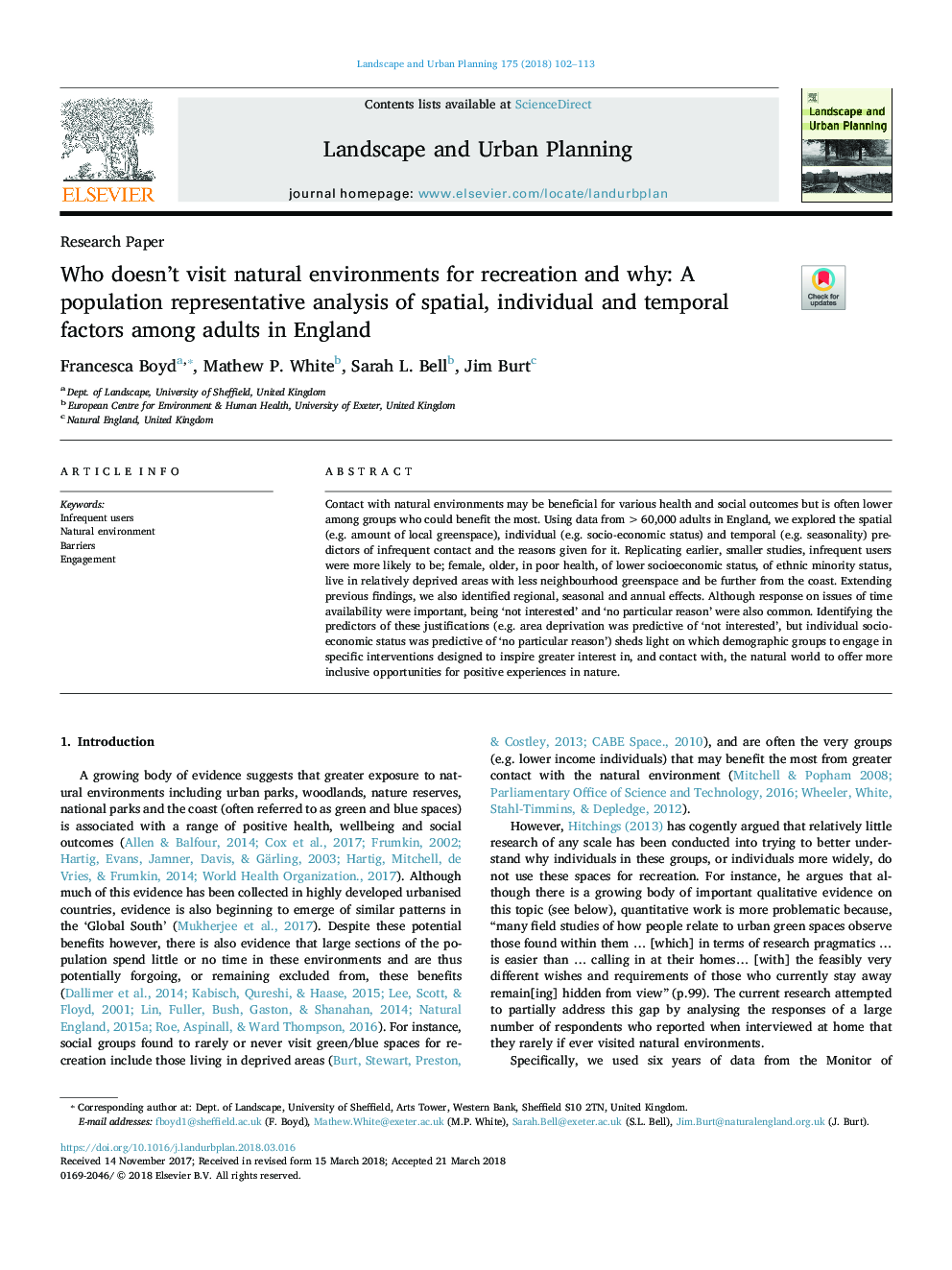| کد مقاله | کد نشریه | سال انتشار | مقاله انگلیسی | نسخه تمام متن |
|---|---|---|---|---|
| 7459772 | 1484583 | 2018 | 12 صفحه PDF | دانلود رایگان |
عنوان انگلیسی مقاله ISI
Who doesn't visit natural environments for recreation and why: A population representative analysis of spatial, individual and temporal factors among adults in England
ترجمه فارسی عنوان
چه کسی از محیط های طبیعی برای تفریح بازدید نمی کند و چرا: تجزیه و تحلیل جمعیتی عوامل فضایی، فردی و زمانی در میان بزرگسالان در انگلستان
دانلود مقاله + سفارش ترجمه
دانلود مقاله ISI انگلیسی
رایگان برای ایرانیان
کلمات کلیدی
کاربران نادر محیط طبیعی، موانع، نامزدی،
ترجمه چکیده
تماس با محیط طبیعی ممکن است برای نتایج سلامت و اجتماعی مختلف سودمند باشد، اما اغلب در میان گروه هایی که بیشترین بهره را می برند، پایین تر است. با استفاده از دادههای بیش از 60000 بزرگسال در انگلستان، ما فضایی (مثلا مقدار فضای سبز محلی)، فرد (مثلا وضعیت اجتماعی-اقتصادی) و پیش بینی کننده زمان (مثلا فصلی) تماس نادرست و دلایل داده شده را بررسی کردیم. در مقایسه با مطالعات کوچکتر، کاربران نادر، بیشتر احتمال داشتند؛ زن، مسن تر، در سلامت ضعیف، وضعیت اجتماعی پایین اقتصادی، وضعیت اقلیت قومی، در مناطق نسبتا محروم با فضای سبز کمتر و در ساحل زندگی می کنند. گسترش یافته های قبلی، ما همچنین اثرات منطقه ای، فصلی و سالانه را شناسایی کردیم. اگر چه پاسخ در مورد مسائل مربوط به زمان در دسترس بودن مهم بود، "علاقه" و "هیچ دلیل خاص" نیز معمول بود. شناسایی عوامل پیش بینی کننده این توجیه (به عنوان مثال محرومیت محله از پیش بینی "علاقه مند" نیست، اما موقعیت اجتماعی و اقتصادی فردی از "هیچ دلیلی خاص" پیش بینی نشده است) روشن می سازد که گروه های جمعیت شناختی درگیر مداخلات خاصی هستند که برای الهام گرفتن از منافع بیشتر طراحی شده اند تماس با جهان طبیعی برای ارائه فرصت های فراگیر برای تجربیات مثبت در طبیعت.
موضوعات مرتبط
علوم زیستی و بیوفناوری
علوم کشاورزی و بیولوژیک
بوم شناسی، تکامل، رفتار و سامانه شناسی
چکیده انگلیسی
Contact with natural environments may be beneficial for various health and social outcomes but is often lower among groups who could benefit the most. Using data from >60,000 adults in England, we explored the spatial (e.g. amount of local greenspace), individual (e.g. socio-economic status) and temporal (e.g. seasonality) predictors of infrequent contact and the reasons given for it. Replicating earlier, smaller studies, infrequent users were more likely to be; female, older, in poor health, of lower socioeconomic status, of ethnic minority status, live in relatively deprived areas with less neighbourhood greenspace and be further from the coast. Extending previous findings, we also identified regional, seasonal and annual effects. Although response on issues of time availability were important, being 'not interested' and 'no particular reason' were also common. Identifying the predictors of these justifications (e.g. area deprivation was predictive of 'not interested', but individual socioeconomic status was predictive of 'no particular reason') sheds light on which demographic groups to engage in specific interventions designed to inspire greater interest in, and contact with, the natural world to offer more inclusive opportunities for positive experiences in nature.
ناشر
Database: Elsevier - ScienceDirect (ساینس دایرکت)
Journal: Landscape and Urban Planning - Volume 175, July 2018, Pages 102-113
Journal: Landscape and Urban Planning - Volume 175, July 2018, Pages 102-113
نویسندگان
Francesca Boyd, Mathew P. White, Sarah L. Bell, Jim Burt,
